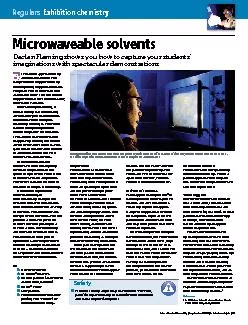/


I was once approached by a confused student who had produced copper oxide by decomposing copper carbonate a label and stuck it on the tube of copper oxide A few seconds later an 145erasable146 ID: 122010
Download Pdf The PPT/PDF document "Education in Chemistry | September 2013 ..." is the property of its rightful owner. Permission is granted to download and print the materials on this web site for personal, non-commercial use only, and to display it on your personal computer provided you do not modify the materials and that you retain all copyright notices contained in the materials. By downloading content from our website, you accept the terms of this agreement.
Education in Chemistry | September 2013 | www.rsc.org/eic | I was once approached by a confused student who had produced copper oxide by decomposing copper carbonate. a label and stuck it on the tube of copper oxide. A few seconds later, an ‘erasable’ pen that becomes heated by rubbing it. Their tube before they stuck on the label. I was able to make their name reappear by sticking the tube in a freezer for a few minutes. This gave me an idea for an extension to a demonstration I do with microwaves and solvents.microwave oven usually only serves to help calculate the speed of light or show the effect of microwaves on a light bulb. illustrate concepts in chemistry. Microwave oven beakers 20 cm3 water Sticky labels Thermochromic ‘erasable’ pen (eg Pilot ‘FriXion’) or thermochromic mugs. Declan Fleming shows you how to capture your students’ imaginations with spectacular demonstrationsMicrowaveable solvents Safety While in theory any non-polar solvent will work,paraffin is particularly suitable for use in schools as it has a higher flashpoint Alternative methodThe beakers can be replaced by thermochromic mugs where a pattern appears when they are hot. Check the mug is microwave safe before you use it!Teaching goal Using paraffin to demonstrate how the polarity of a solvent affects how efficiently a microwave oven can heat it.See how to perform this demonstration at http://rsc.li/EiC513ec RegularsExhibition chemistry